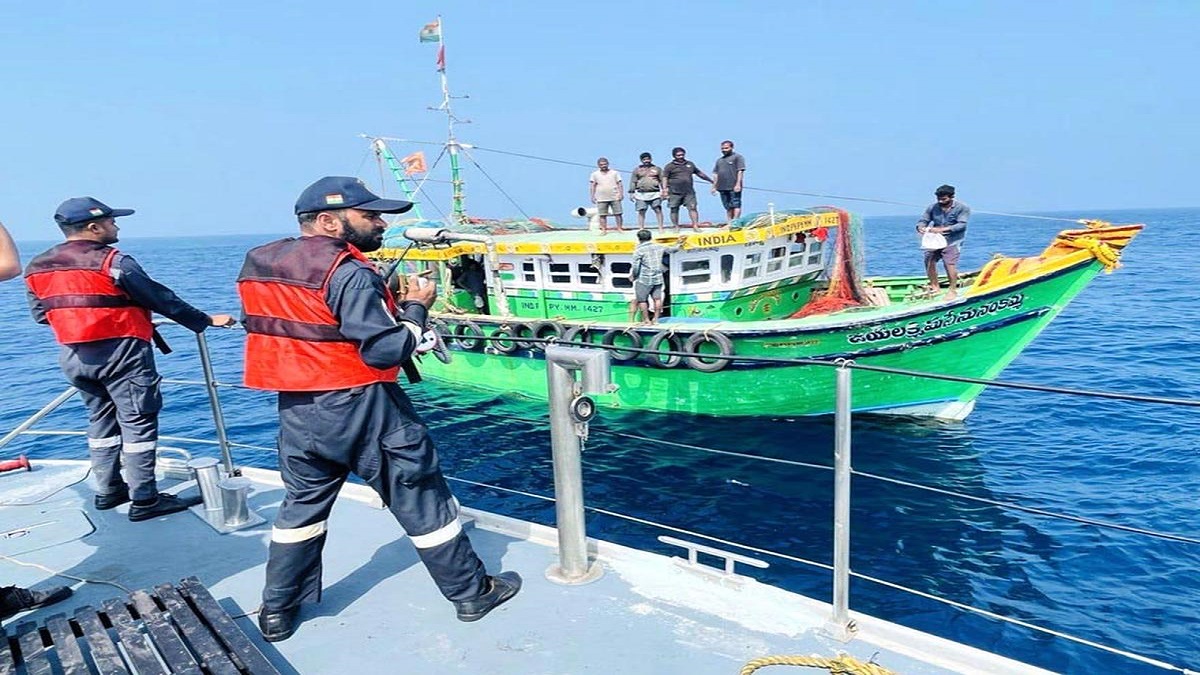The Indian Coast Guard (ICG) successfully conducted the ‘Sagar Kavach’ security exercise along the 158 km West Bengal coastline on February 21-22, 2025. This two-day operation aimed to test and enhance the coastal security mechanism by involving multiple agencies in tackling simulated threats. The exercise focused on refining Standard Operating Procedures (SOPs) and strengthening inter-agency coordination to counter potential threats along India’s eastern maritime border.
What Were the Key Scenarios in the ‘Sagar Kavach’ Exercise?
The ‘Sagar Kavach’ exercise was designed to simulate real-life security threats and measure the preparedness of maritime forces. Several threat-based scenarios were included in the drills:
- Hijacking Incidents: Security forces handled scenarios where fishing boats and barges were hijacked, replicating potential terrorist landings and hostage situations.
- Smuggling Operations: The drills tested the response to illegal transportation of goods and contraband along the coastline, a known security challenge in the region.
- IED Threats: The exercise also included the detection and disposal of improvised explosive devices (IEDs) planted on critical infrastructure, such as ports and jetties.
By covering a broad range of security threats, the exercise ensured that all agencies involved were well-equipped to deal with real-world situations.
How Did Different Agencies Collaborate in ‘Sagar Kavach’?
A major highlight of the security exercise was the coordinated effort between multiple agencies. The Indian Coast Guard led the operation, but several other security and enforcement agencies played critical roles:
- Maritime Patrols: The ICG, Navy, West Bengal Police, CISF, BSF, and Customs conducted active patrolling across the coastline, ensuring a multi-layered security cover.
- Coastal Surveillance: District police and forest department personnel enhanced on-ground monitoring, keeping a close watch on suspicious activities.
- Community Engagement: Fishermen’s watch groups played a key role as informants, acting as the “Eyes and Ears” of security forces. Their contribution was crucial in reporting potential threats from the ground level.
This joint operation not only improved the efficiency of security measures but also ensured seamless coordination among agencies.
Why is the ‘Sagar Kavach’ Exercise Important for West Bengal?
West Bengal’s coastline is strategically significant due to its geographical and economic features:
- Large Maritime Community: Over 330,000 fishermen and 16,000 fishing boats operate in the region, making security monitoring complex.
- High-Value Infrastructure: The presence of two major ports, several river ports, jetties, and industries makes it a potential target for security threats.
- Porous Borders: The region’s riverine geography creates challenges in monitoring unauthorized movements, making security exercises like ‘Sagar Kavach’ essential.
The continuous evolution of this exercise is part of a larger strategy to strengthen coastal security. Previous editions, such as the one held on September 25-26, 2024, focused on similar security challenges, demonstrating the Indian Coast Guard’s commitment to proactive defense measures.
Key Highlights of ‘Sagar Kavach’ Exercise
| Aspect | Details |
|---|---|
| Why in News? | The Indian Coast Guard conducted the ‘Sagar Kavach’ coastal security drill in West Bengal on February 21-22, 2025. |
| Location | West Bengal coastline (158 km stretch) |
| Key Threat Scenarios | Hijacking, smuggling, IED threats |
| Participating Agencies | Indian Coast Guard, Navy, BSF, CISF, West Bengal Police, Customs, Forest Department |
| Objective | Test and enhance coastal security SOPs, strengthen inter-agency coordination |
| Strategic Importance | West Bengal’s porous riverine coastline, major ports, and large maritime community |
| Previous Exercise | Conducted on September 25-26, 2024 |



 Exercise Desert Cyclone II Begins: India...
Exercise Desert Cyclone II Begins: India...
 Army Achieves Major Logistics Milestone ...
Army Achieves Major Logistics Milestone ...
 India and Brazil Sign Tripartite MoU on ...
India and Brazil Sign Tripartite MoU on ...







